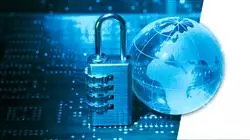University certificate
The world's largest faculty of information technology”
Introduction to the Program
Thanks to this program, you will learn the best encryption methods to protect your clients' and employers' data"

Cryptography is a booming discipline for which professionals are increasingly in demand. This field makes it possible to protect all types of digital data and has applications in areas such as banking, online stores, databases of all kinds and is essential in the Blockchain. Thus, specializing in this area is a must for today's IT professional.
Many companies, not just technology companies, need cryptographic experts to make their information more secure, and this program responds to that demand. Throughout 3 modules, and in 450 hours of learning, the computer scientist will be able to delve into issues such as the mathematical foundations of cryptography, the methodology of analysis and risk management of information systems or the protection of algorithms against quantum computing.
The professional will be able to deepen in this discipline through a 100% online methodology, specially designed so that the student can combine their work with their studies. In addition, the program will be taught by a teaching staff of great prestige in the field of cryptography, who will teach this program using
numerous multimedia resources.
Cryptography is basic to companies like Facebook, Paypal or Amazon, and Blockchain technology has given it a huge boost, so specializing in this area can give access to numerous career opportunities"
The Postgraduate diploma in Security and Cryptography is the most complete and up-to-date educational program on the market. Its most notable features are:
- The development of case studies presented by IT and cybersecurity experts
- The graphic, schematic, and practical contents with which they are created, provide scientific and practical information on the disciplines that are essential for professional practice
- Practical exercises where the self-assessment process can be carried out to improve learning
- Its special emphasis on innovative methodologies
- Theoretical lessons, questions to the expert, debate forums on controversial topics, and individual reflection work
- Content that is accessible from any fixed or portable device with an Internet connection
From the best multimedia materials, and with a teaching staff composed of working professionals, you will learn all the keys to cryptography applied to computer security"
The program includes, in its teaching staff, professionals from the sector who bring to this training the experience of their work, in addition to recognized specialists from prestigious reference societies and universities.
The multimedia content, developed with the latest educational technology, will provide the professional with situated and contextual learning, i.e., a simulated environment that will provide immersive training programmed to train in real situations.
This program is designed around Problem-Based Learning, whereby the professional must try to solve the different professional practice situations that arise throughout the program. For this purpose, the student will be assisted by an innovative interactive video system created by renowned and experienced experts.
Cryptography is the big IT field of today: this program will allow you to specialize in it with the best online teaching on the market”

With this Postgraduate Diploma you will delve into aspects of cryptography such as the protection of algorithms against quantum computing”
Why study at TECH?
TECH is the world’s largest online university. With an impressive catalog of more than 14,000 university programs available in 11 languages, it is positioned as a leader in employability, with a 99% job placement rate. In addition, it relies on an enormous faculty of more than 6,000 professors of the highest international renown.

Study at the world's largest online university and guarantee your professional success. The future starts at TECH”
The world’s best online university according to FORBES
The prestigious Forbes magazine, specialized in business and finance, has highlighted TECH as “the world's best online university” This is what they have recently stated in an article in their digital edition in which they echo the success story of this institution, “thanks to the academic offer it provides, the selection of its teaching staff, and an innovative learning method aimed at educating the professionals of the future”
A revolutionary study method, a cutting-edge faculty and a practical focus: the key to TECH's success.
The most complete study plans on the university scene
TECH offers the most complete study plans on the university scene, with syllabuses that cover fundamental concepts and, at the same time, the main scientific advances in their specific scientific areas. In addition, these programs are continuously being updated to guarantee students the academic vanguard and the most in-demand professional skills. In this way, the university's qualifications provide its graduates with a significant advantage to propel their careers to success.
TECH offers the most comprehensive and intensive study plans on the current university scene.
A world-class teaching staff
TECH's teaching staff is made up of more than 6,000 professors with the highest international recognition. Professors, researchers and top executives of multinational companies, including Isaiah Covington, performance coach of the Boston Celtics; Magda Romanska, principal investigator at Harvard MetaLAB; Ignacio Wistumba, chairman of the department of translational molecular pathology at MD Anderson Cancer Center; and D.W. Pine, creative director of TIME magazine, among others.
Internationally renowned experts, specialized in different branches of Health, Technology, Communication and Business, form part of the TECH faculty.
A unique learning method
TECH is the first university to use Relearning in all its programs. It is the best online learning methodology, accredited with international teaching quality certifications, provided by prestigious educational agencies. In addition, this disruptive educational model is complemented with the “Case Method”, thereby setting up a unique online teaching strategy. Innovative teaching resources are also implemented, including detailed videos, infographics and interactive summaries.
TECH combines Relearning and the Case Method in all its university programs to guarantee excellent theoretical and practical learning, studying whenever and wherever you want.
The world's largest online university
TECH is the world’s largest online university. We are the largest educational institution, with the best and widest online educational catalog, one hundred percent online and covering the vast majority of areas of knowledge. We offer a large selection of our own degrees and accredited online undergraduate and postgraduate degrees. In total, more than 14,000 university degrees, in eleven different languages, make us the largest educational largest in the world.
TECH has the world's most extensive catalog of academic and official programs, available in more than 11 languages.
Google Premier Partner
The American technology giant has awarded TECH the Google Google Premier Partner badge. This award, which is only available to 3% of the world's companies, highlights the efficient, flexible and tailored experience that this university provides to students. The recognition as a Google Premier Partner not only accredits the maximum rigor, performance and investment in TECH's digital infrastructures, but also places this university as one of the world's leading technology companies.
Google has positioned TECH in the top 3% of the world's most important technology companies by awarding it its Google Premier Partner badge.
The official online university of the NBA
TECH is the official online university of the NBA. Thanks to our agreement with the biggest league in basketball, we offer our students exclusive university programs, as well as a wide variety of educational resources focused on the business of the league and other areas of the sports industry. Each program is made up of a uniquely designed syllabus and features exceptional guest hosts: professionals with a distinguished sports background who will offer their expertise on the most relevant topics.
TECH has been selected by the NBA, the world's top basketball league, as its official online university.
The top-rated university by its students
Students have positioned TECH as the world's top-rated university on the main review websites, with a highest rating of 4.9 out of 5, obtained from more than 1,000 reviews. These results consolidate TECH as the benchmark university institution at an international level, reflecting the excellence and positive impact of its educational model.” reflecting the excellence and positive impact of its educational model.”
TECH is the world’s top-rated university by its students.
Leaders in employability
TECH has managed to become the leading university in employability. 99% of its students obtain jobs in the academic field they have studied, within one year of completing any of the university's programs. A similar number achieve immediate career enhancement. All this thanks to a study methodology that bases its effectiveness on the acquisition of practical skills, which are absolutely necessary for professional development.
99% of TECH graduates find a job within a year of completing their studies.
Postgraduate Diploma in Security and Cryptography
.
Information security is one of the major concerns of today's society, especially for companies and institutions that handle sensitive data. In this context, cryptography has become a fundamental pillar in cybersecurity, as it allows data to be protected through the encryption process and the use of tools such as algorithms. TECH's Postgraduate Diploma in Security and Cryptography focuses on symmetric cryptography, block ciphers, quantum algorithms and Blockchain technology. In addition, the program has a 100% online teaching system, which will allow you to combine your studies with your work.
An extensive library of specialized content in cybersecurity
.
The Postgraduate Diploma in Security and Cryptography will allow you to delve into the mathematical foundations of cryptography, the methodology of analysis and risk management of information systems, the protection of algorithms against quantum computing and many other essential issues in this area. In addition, you will have a teaching staff of great prestige in this sector, who will teach the program from numerous multimedia resources.







